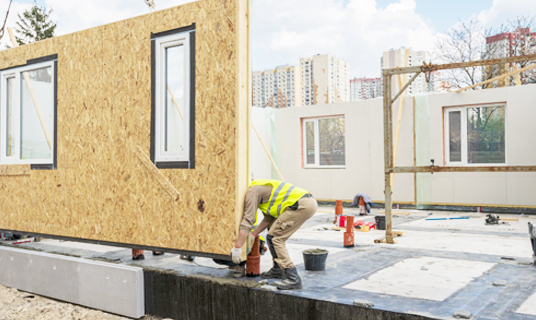If you’ve yet not started to figure Pre-Manufactured Value (PMV) into your planned new-build projects, then chances are you will have heard of it. Consortium Procurement Construction explores
We’ve written about it a couple of times (check out the links at the bottom of this article to read more) because it’s going to be so essential to the future of public sector home building.
The Government is placing a significant emphasis on Modern Methods of Construction (MMC), investing time and money in various policies and schemes – not least Home England’s Affordable Homes Programme – which is only set to grow as the market matures. Central to the MMC agenda is the use of PMV as a key measurement metric, so it’s vital to understand what it means and how it will affect your projects, now and in the future.
We’ve taken a look back on one of our recent projects, and applied the PMV calculation formula to help illustrate.
What is Pre-Manufactured-Value (PMV)?
Pre-Manufactured Value (PMV) is a way of calculating the proportion of a building’s construction that takes place offsite or near-site using any of the seven categories of MMC, measured as a percentage of the total.
MMC categories 1 and 2 (volumetric and panelised systems) offer the highest PMV, as they will account for most of the structure being constructed offsite. Not all MMC has to be pods and modular buildings though, and more well-established and proven construction methods such as closed panel timber frame systems also gain you PMV points. The further down the category list you go, the lower the PMV contributed, but every little bit adds up to the total PMV.
The government has introduced PMV as a central plank to its Affordable Homes Programme, under which 25% of funded projects must be delivered using MMC; homes will only be classed as MMC if they have a PMV score of 55% or more.
PMV provides a framework for measuring progress, and we’re expecting that we will see its use across more policies in the future, so it’s good to get to grips with how it works now.
As ever with construction, there are a lot of three-letter acronyms in there, but I hope it makes sense!
If you want to assess how different MMC products and processes affect a project’s PMV, there’s a handy online calculator tool.
In the meantime, we’ve taken a look at one of our recent projects and, with manufacturer MAR Offsite, worked out its PMV to demonstrate.
PMV in practice
Knutton Crescent in Parson Cross, Sheffield, is a site of four MMC-built, four-bedroom family homes (read our detailed case study here).
Sheffield City Council wanted to build the homes with a view to incorporating MMC as part of its Stock Increase Programme, which aims to deliver 3,100 new council homes by 2029. CPC worked closely with them to procure the services of MAR.
The homes were built using a precision-engineered, light gauge steel frame volumetric system, in MAR’s factory in East Yorkshire. They look and feel like traditionally-built home, with a brick exterior and pitched roof. But they are more energy efficient, having been constructed with a fabric first approach, making them more airtight and providing better insulation.
The homes were handed over within just 10 months of the start of initial design work, and occupied less than five months before the modules were lifted into place on site – getting the families in their homes in time for Christmas.
What’s more, we’re delighted that the project has been shortlisted for Social Housing Project of the Year in the Offsite Awards.
So, what was the PMV for the project?
Using the calculator tool, MAR crunched the numbers. As Knutton Crescent was built using what the calculator classes as “structural chassis and internal fit out – ‘podded’ room assemblies – bathrooms/kitchens etc”, this immediately provides a PMV of 69.74%, well beyond the 55% required from Affordable Homes Programme projects.
Added to that, MMC category 6 works were also used, categorised in the calculator as “easy site install/jointing/interfacing features – brick slips, modular wiring, flexible pipework”, which brings the PMV to 71.99%.
The other value of MMC
Quite aside from the quantifiable, measurable PMV, modern methods of construction also tend to create a huge amount of social value for all of those involved.
As I mentioned, we were able to get those families into their new homes in time for Christmas. They will be warmer and more comfortable, with lower heating bills and less chance of going into fuel poverty, with the excellent energy efficiency offered by MMC as opposed to traditional methods. This also means carbon emissions are reduced, and due to the materials used, lower labour and speedier delivery, the embodied carbon of the buildings will be much lower – an important factor to consider as the energy grid decarbonises.
The council was able to start seeing a return on its investment more quickly, as the project time from design to occupation was much shorter. Less site time also meant less disruption for neighbours in terms of noise, traffic and mess.
LHC puts social value at the heart of its procurement frameworks, so we’re always thrilled to help clients and suppliers deliver a project like this, that has so many benefits.
CPC staff and I recently took a trip to the MAR factory in East Yorkshire, and were overawed with the processes and quality of the products they’re building.
We know it’s early days for most social housing providers in their MMC journey, and as I’ve written before, many will be reluctant to enter the market and be “early adopters” due to the known and unknown problems that may be encountered with this relatively new technology.
But watching the MAR crew in action and hearing about their plans for the future has really heartened me and my team, and reassured us that the future is very bright for MMC and those who invest in it.
The Knutton Crescent project was delivered through our NH2 Offsite Construction of New Homes Framework.
To read more about PMV, check out our previous blogs:
- Want to explore MMC but not sure where to start? Here’s how…
- Dispelling the myths of MMC in the public sector
- It’s boom time for MMC – time to get involved














